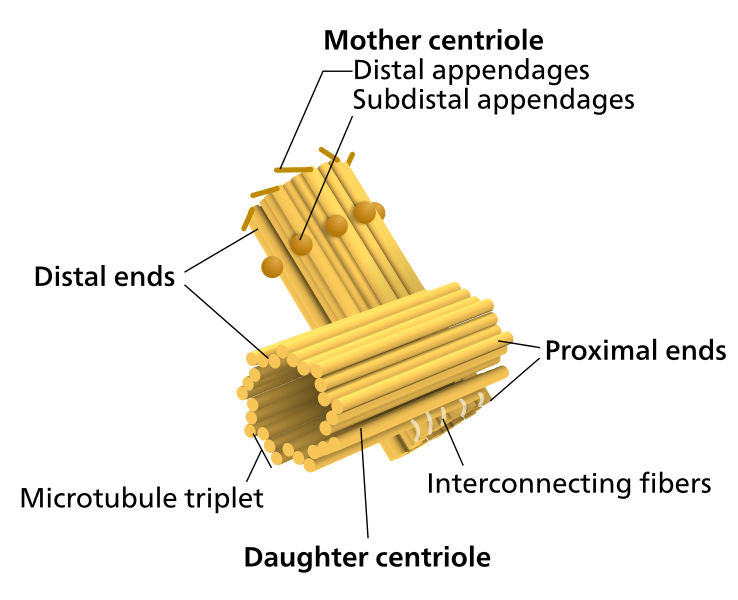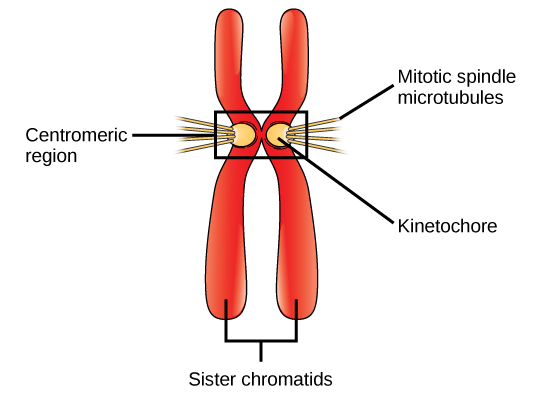The key difference between centriole and centromere depends on its function. Centrioles involve in the synthesis and organizing of spindle fibers whereas centromeres provide a site of attachment to the spindle fibers.
Cell division is an important aspect in the context of continuity of life. It enables the organisms to grow and maintain important functions in the body. Cell division is a complex process that involves different types of structures and organelles present within the cell. Accordingly, centriole and centromere are closely related structures. The centriole is an organelle while the centromere is a region of the chromosome. Both structures are important for cell division and its progression.
CONTENTS
1. Overview and Key Difference
2. What is a Centriole
3. What is a Centromere
4. Similarities Between Centriole and Centromere
5. Side by Side Comparison – Centriole vs Centromere in Tabular Form
6. Summary
What is a Centriole?
Centriole is a small cylindrical organelle present in most eukaryotic cells. Also, they are present in other types of flagellated cells. Furthermore, centrioles contain tubulin protein as their main protein. The cylindrical structure of centriole comprises the several groups of microtubules that are in 9 + 3 structure. When two centrioles arranged perpendicular to each other, it forms a centrosome. This centrosome works as the main center of microtubule arrangement, and it regulates the progression of the cell cycle. During the cell division, centrioles play a significant role by determining the plane in which the nuclear division takes place within the cell.

Figure 01: Centriole
Furthermore, centrosomes form spindle fibers to attach with the centromeres of the chromosomes. Therefore, the main function of centrioles is to organize spindle fibers (spindle) during mitosis and meiosis (cell division). Even though centrioles are present in most of the animal cells, they are absent in conifers, flowering plants and most species of fungi.
What is a Centromere?
Centromere is a structure present within a chromosome that connects two chromatids. It is a visible point of constriction in the chromosome. Centromere contains repeated sequences of DNA and specific proteins. These proteins create a disk-shaped structure called kinetochore at the centromere. Kinetochore involves in cell signalling for the progression of the cell cycle, and it serves as the main attachment site for spindle microtubules.

Figure 02: Centromere
Centromeres are of two types namely, regional centromeres and point centromeres. Point centromeres establish a single direct line of attachment per chromosome and bind to different specific proteins. These proteins recognise highly efficient DNA sequences. But regional chromosomes establish multiple attachments per chromosome. Regional centromeres are more prevalent in cells of organisms rather than point centromeres.
What are the Similarities Between Centriole and Centromere?
- Centriole and centromere are important structures for cell division.
- Both are present within the cell.
What is the Difference Between Centriole and Centromere?
Centriole is a cell organelle while centromere is a region of the chromosome. This is the key difference between centriole and centromere. Furthermore, centrioles form spindle fibers, and centromeres provide attachment sites for the spindle fibers during the cell division. Thus, it is another difference between centriole and centromere. Moreover, centriole and centromere differ from each other on the makeup as well. So, the difference between centriole and centromere make up is that the centrioles are made up of microtubulin proteins while centromeres are made up of heterochromatin.
The below infographic on difference between centriole and centromere shows more infomation on the differences.

Summary – Centriole vs Centromere
Cell division is as an important aspect for continuity of life. Certain structures such as centrioles and centromeres are essential for the cell division. Centrioles are small cylindrical organelles made out of tubulin protein. They are present in most eukaryotic cells expect in higher plants and most of the fungi. Furthermore, microtubules of centrioles are arranged in a special 9+3 structure. On the other hand, centromere is a structure present within a chromosome which connects two chromatids together. They are of two types, point centromeres and regional centromeres. Thus, this summarises the difference between centriole and centromere.
Reference:
1.Britannica, The Editors of Encyclopaedia. “Centromere.” Encyclopædia Britannica, Encyclopædia Britannica, Inc., 24 May 2012. Available here
2.BiologyWise, “Centriole Functions.” BiologyWise, 18 Apr. 2018. Available here
Image Courtesy:
1.”Centriole-en”By Kelvinsong – Own work, (CC BY 3.0) via Commons Wikimedia
2.”Figure 10 02 03″By CNX OpenStax (CC BY 4.0) via Commons Wikimedia
ncG1vNJzZmivp6x7pbXFn5yrnZ6YsqOx07CcnqZemLyue8OinZ%2Bdopq7pLGMm5ytr5Wau26vxKerq6GfobJurc2dZK%2BrXZiyr8DRqKSeqpVk